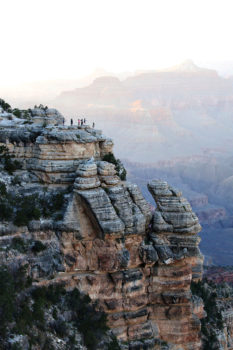 Bill Raymond
Bill Raymond
Taking pictures of beautiful landscapes is always tempting. I’ve taken thousands of them. Often, later when I look at them, I don’t even find them interesting. I’m sure friends who saw them felt the same way, but they were too polite to say so. Somehow the magnificent sight I saw when I took the picture just didn’t come through in the print. Grand Canyon is an excellent example. I’ve tried many times to capture the grandeur of the canyon. Too often the results lack any real sense of interest or depth.
Our minds just don’t grasp that those little green dots in the picture are giant trees, or that opposite canyon wall is miles away. Also, when you take a picture looking across the canyon, haze mutes the other side. Taking pictures in early morning or late afternoon helps, but the pictures can still look flat and uninteresting.
If you haven’t tried this, consider taking pictures on your side of the canyon. This focuses more attention on canyon textures and addresses the haze issue pretty well. Including people in the picture also helps with scale; our minds know that people are about six feet tall and that size pales in comparison to the depth of the canyon below.
Another thing to look for is whether or not the picture contains a story. I took several pictures of the rock formation shown here. All of them had people in them. I liked this one the best because the girl is walking back up the rocks from the edge. The story in my mind is that she walked all of the way to the cliff and lived to get back.
My only regret with this shot is that I didn’t take a second picture, aiming lower, and then stitching the two together to make a vertical panorama that shows more of the cliff.
Another tip; if you make prints consider making them larger. This print in 4×6 and 13×19 look incredibly different.
Bill Raymond teaches photography workshops for the PebbleCreek Art Club. Beginner to intermediate workshops will be offered after the first of the year.
